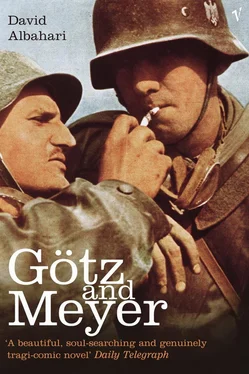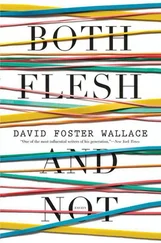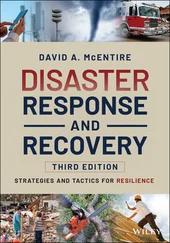The story was that there had been five of them, but since the job turned out to be pretty strenuous — they had to lug the corpses out and bury them in a grave in no time flat — seven is a more likely number. At first they used to take care with the corpses — this was a dead person after all, an asphyxiated woman, a convulsed little child — but then they got to the point where they grabbed each one they came to, there wasn’t time to be respectful, not when there were so many, and each one was heavier than any living being would have been. Death is heavy. Death is a weight. Another group of prisoners had dug the grave, though the first seven never saw the others, the graves were already ready before they got there, which was, at least, some sort of consolation. What were Götz and Meyer up to at this point? I expect they were chatting with the camp commander, one of them was certainly smoking, and there was the business of crawling back under the truck and re-attaching the exhaust pipe. Little by little, the day would pass. There was always something to do. Götz and Meyer took their seats in the cab, the camp commander got into his car, the four German guards drove the seven Serbian prisoners off in their vehicle. Behind them, the freshly filled grave was still, but by the next day the soil would start buckling, the gases would cause blisters of earth to bulge. There was no avoiding it, Götz and Meyer might have thought, every job has its downside. They drove slowly, there was no hurry. Later, in the evening, one of them would read a book, while the other went for a stroll. You could say that they felt no aftereffects from their everyday duties, no pressures from horrible scenes, they suffered no discomfort from nightmares. They were in fine shape, had a good appetite, there was no residue of disturbing thoughts, not even nostalgia for their homeland. They were, in fact, the best proof of how advances in technology enhance the stability of the human personality. They were living proof that Reichsführer Himmler had been right when he claimed that a more humane form of killing might ease the psychological burden felt by those members of the task forces assigned to shooting Russians and Jews. Here, Götz and Meyer felt no burden at all. Himmler would, I’m sure, have been delighted had he met them. Apparently in August 1941 somewhere near Minsk he was present at a large-scale execution before a firing squad. When he peered into the grave and saw that several of the victims were still alive, and that they were twitching and moaning, he was nauseated. I have no idea whether he vomited and stained his trim uniform, but going pale, knees knocking, was highly improper for a German officer. So when he got back to Berlin, he issued an order to all the services to work out a method of killing that might boost the morale of both the victims and the soldiers assigned to the executions. All the challenges inherent in such a task were met within fewer than four months, and after successful trial runs with Soviet prisoners of war in Sachsenhausen, by the spring of 1942 they had completed the production of thirty special trucks, twenty large ones like our Saurer, and ten smaller ones, Diamonds or Opelblitzes. This truck, one should note, had its predecessor in a hermetically sealed vehicle used as part of the euthanasia programme for the mentally ill, in which the victims were put to death with pure carbon monoxide. The brilliant innovation that made Himmler’s idea a reality, and that was, after all, key to the further advancement of mass-murder technology, consisted of using engine exhaust instead of carbon monoxide from steel canisters, not only making the whole procedure considerably less costly but also enhancing the impression that the interior of the truck was completely innocent: it looked like the
genuine interior of a
genuine truck, which certainly had a salutary effect on the victims. It was difficult, I admit, to resist such attention to detail. It did turn out, however, that things were not as simple as that, regardless of the improvement to the victims’ spiritual state, because the members of the task forces found that unloading asphyxiated people actually provoked greater psychological discomfort than ordinary firing-squad executions did. At the camp where Götz and Meyer worked, this problem was resolved by engaging the efforts of the seven, or possibly five, Serbian prisoners. They were the ones who dragged out the dead, lined them up in the graves and buried them. Once they had finished filling the last of the graves, they were shot. I believe that Götz and Meyer saw this, though it is also entirely possible that before this happened they had already set out, following the commander’s car, for the Fairgrounds camp, which was emptying. There were always bureaucratic details to be seen to. This happened, as the documents tell us, on May 10, 1942. A month later, the Saurer was on its way back to Berlin. Götz and Meyer went with it. Its rear axle had broken, so it was transported by train. Götz and Meyer most certainly had their own compartment. Those four German policeman had a special compartment, they had earned an extra week of leave, so why not Götz and Meyer? There is nothing to suggest what led to the broken axle, nor is it known why the truck stayed on in Belgrade, unused, for a month when, at least we know this much, its services were sorely needed elsewhere. It is also not at all clear why that axle, if it had to go and break, hadn’t snapped long before, thereby slowing the inevitable pace of the suffering. God was not doing much at this juncture for his chosen people. Perhaps he was busy in some other corner of the world, or perhaps he wanted to let the people know they weren’t so chosen after all? If a person can’t trust the gods, how can he trust other people? The children, for instance, trusted Götz, or was it Meyer, when he strode briskly into the camp, warmed by the spring sun, picked them up and gave them sweets. How Götz, or was it Meyer, loved children! It would be hard to find the right words to describe the warmth he felt when his hands rested on those tousled little heads. He gave no thought to lice at moments like that, although he could often spot them crawling in the closely cropped hair. Should I assume, therefore, that Götz, or was it Meyer, was married? Did he have a wife, perhaps children, somewhere in Germany or, maybe, Austria? The other one, the one who did not venture into the camp, probably wasn’t married. Love for children doesn’t come from heaven — God was not there anyway — rather, it’s something you learn, like everything else. Although, I must admit, there is no harm in thinking that he, the other one, in fact refused to pretend. He was there on a certain assignment, and nothing but that job existed for him. While the other fellow was in the camp, he was seeing to administrative work or sitting in the truck with his foot on the accelerator, waiting. Maybe he smoked. He probably smoked. Everyone smoked back then. As far as that is concerned, the world hasn’t changed. Cigarettes have got thinner, filters have reached design perfection, tobacco has become more aromatic, but nothing in them evokes the flood that, at the time of this story, had enveloped the world like slippery slime. Flood, perhaps, is not the best word to use when speaking of people dying from poison gas, but the sensation of submersion is the same. You reach bottom, and that is the end, there is nowhere left to go. Death is not a balloon but an anchor. The souls, indeed, flew up when the truck arrived at its destination, frantic for fresh air, but the bodies stayed below, sometimes so tangled that the Serbian prisoners cursed softly through their clenched teeth as they did what they could to disentangle the arms and legs and crisscrossed fingers. They’d been promised, I read this somewhere, that after they’d completed the job successfully they’d be sent off to a work camp in Norway, and so they lived for two months within a delusion that was part and parcel of the greater delusion, a performance in which each played the role he had been assigned.
Читать дальше












